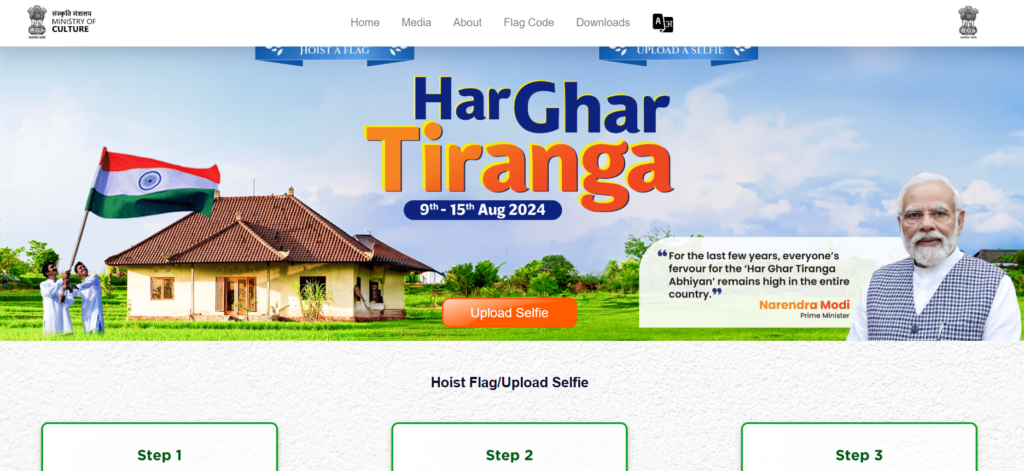Overview of Har Ghar Tiranga campaign
Har Ghar Tiranga, an initiative under the Azadi Ka Amrit Mahotsav, is designed to instill a sense of patriotism and national unity among Indian citizens. This campaign invites every household to display the national flag from August 13 to 15, 2024, marking the nation’s Independence Day celebrations.
Purpose and Significance
The primary aim of the Har Ghar Tiranga campaign is to:
- Promote Patriotism: Encouraging citizens to hoist the national flag at their homes fosters a collective feeling of pride and love for the country.
- Strengthen National Identity: Displaying the flag unifies diverse communities under a shared symbol, reinforcing a sense of belonging and national identity.
- Engage Citizens Actively: By participating in this initiative, individuals actively contribute to the celebration of India’s independence, highlighting their role in the nation’s history.

Connection with Azadi Ka Amrit Mahotsav
Azadi Ka Amrit Mahotsav commemorates 75 years of India’s independence. The Har Ghar Tiranga 2024 campaign aligns with this grand celebration by:
- Honoring Historical Milestones: Reflecting on significant events that led to India’s freedom and progress.
- Encouraging Participation: Inviting citizens to partake in various activities that celebrate India’s cultural heritage and achievements.
- Rekindling Patriotic Sentiments: The act of hoisting the tricolor serves as a reminder of the sacrifices made for freedom and inspires a renewed commitment to nation-building.
Independence Day Celebrations
August 15 is not just a date; it signifies resilience, freedom, and unity. The Har Ghar Tiranga campaign enhances these celebrations by:
- Creating Visual Harmony: A sea of tricolors across homes creates a powerful visual representation of unity.
- Educational Opportunities: It offers a platform for educating younger generations about the significance of Independence Day and fostering respect for national symbols.
- Community Engagement: Bringing neighbors together through shared activities like flag hoisting ceremonies strengthens community bonds.
Important Dates for Har Ghar Tiranga 2024 Campaign
Dates to Remember: August 13 – 15, 2024
The Har Ghar Tiranga 2024 campaign encourages citizens to hoist the national flag from August 13 to 15, 2024. These dates are crucial as they coincide with the celebrations of India’s Independence Day, making them even more significant.
Participation Timeline
To ensure seamless involvement:
Preparation Phase (Before August 13):
- Register on the official campaign website.
- Acquire a high-quality national flag adhering to Flag Code of India regulations.
- Plan your flag-hoisting setup at home or other suitable locations.
Display Period (August 13 – August 15):
- Hoist the flag from August 13 morning.
- Maintain proper flag etiquette throughout these days.
- Capture a selfie with the flag and upload it using hashtag #HarGharTirangaOnceAgain.
Post Celebration:
- Download your participation certificate from the official website after verification.
By marking your calendar for these important dates, you actively partake in a nationwide movement that celebrates our shared heritage and identity. Displaying the tricolor during these three days amplifies its meaning and connects us all under one flag.
How to Register for Har Ghar Tiranga 2024 Campaign?
- Visit the official website: harghartiranga.com
- Fill out the registration form when it becomes available.

- Provide your name, mobile number, and location details.
- Complete the free registration for the campaign pledge.
- Receive a confirmation email upon successful registration.
- Hoist the national flag at your home from August 9-15, 2024.
- Take a selfie with the hoisted flag.
- Upload the selfie to the campaign website.
- Download your participation certificate from the website.
Download Your Har Ghar Tiranga 2024 Certificate
- Visit the official website: harghartiranga.com
- Click on the ‘Upload Selfie with Flag’ button on the home page
- Enter your name in the provided field
- Upload a selfie of yourself properly hoisting the National Flag
- Check the consent checkbox and click the submit button
- Wait for your personalized Har Ghar Tiranga certificate to be generated
- Click on the ‘Download’ option to save your certificate
The Story Behind Our Indian Tricolor Flag
The Indian National Flag, a powerful symbol of our nation’s unity and pride, has undergone significant transformations before arriving at its current form. Before 1931, various flags represented India, each reflecting the country’s evolving identity and aspirations.
1. Pre-Independence Era
In the early 20th century, the first flag representing Indian independence was unfurled by Madame Cama in 1907. Known as the “Flag of Indian Independence,” it featured green, saffron, and red stripes with symbols like the sun and crescent moon. This flag played a crucial role in galvanizing support for India’s freedom struggle abroad.
2. 1921 Gandhi’s Proposal
Mahatma Gandhi proposed a tricolor flag with white, green, and red stripes during the All India Congress Committee session. The colors symbolized different communities in India: red for Hindus, green for Muslims, and white for peace among all. A spinning wheel at the center represented self-reliance.
3. 1931 Adoption
The tricolor design was officially adopted in 1931. This version had saffron at the top, white in the middle with a charkha (spinning wheel) in navy blue, and green at the bottom. The colors were chosen to represent courage and sacrifice (saffron), truth and peace (white), and faith and chivalry (green).
Significance of Colors and Symbols
The current design of our national flag was adopted on July 22, 1947, just before India gained independence from British rule. Each element of the flag holds deep meaning:
- Saffron: Representing courage and sacrifice, saffron is a reminder of the bravery displayed by countless freedom fighters who laid down their lives for India’s independence.
- White: Symbolizing peace and truth, white acts as a beacon guiding us towards harmony and honesty in our national endeavors.
- Green: Denoting fertility and growth, green underscores India’s rich agricultural heritage and its commitment to sustainable development.
- Ashoka Chakra: At the center of the white band lies the Ashoka Chakra, a navy blue wheel with 24 spokes. This symbol is inspired by the Lion Capital of Ashoka at Sarnath. It signifies law, justice, and progress. The Chakra serves as a constant reminder of movement—a nation that stands still stagnates.
Key Figures
Mahatma Gandhi’s influence on the evolution of our national flag underscores his vision for an inclusive India where diverse communities coexist peacefully. Madame Cama’s contributions highlight the global dimension of India’s freedom struggle.
This section provides an insightful look into the historical evolution of our beloved tricolor flag while emphasizing its symbolic significance. Understanding this journey enhances our appreciation of what it means to hoist this flag during campaigns like Har Ghar Tiranga.
Guidelines for Waving the Tiranga Correctly: A Billion Hearts, One Flag
The Flag Code of India establishes the rules and guidelines for the proper display and usage of the Indian national flag. Its primary objective is to ensure that the national flag is treated with dignity and respect. The regulations cover various aspects such as:
- Hoisting and Lowering: The flag should be hoisted briskly and lowered slowly with due respect.
- Positioning: When displayed horizontally, the saffron band must be on top. If displayed vertically, the saffron band should be on the left.
- Prohibited Uses: The flag should not be used as a drapery, decoration, or clothing material. It’s also prohibited to embroider or print it on cushions or handkerchiefs.
Guidelines for Displaying Our National Flag Respectfully
Displaying the Indian tricolor at home or in public spaces requires adherence to specific guidelines to honor its significance:
Material and Condition:
- Use flags made from hand-spun or woven wool, cotton, silk, or khadi.
- Ensure that the flag is always in good condition—clean, undamaged, and without any inscriptions.
Hoisting:
- Hoist the flag at a prominent position where it can fly free and be clearly visible.
- The flag should be hoisted higher than any other flags nearby.
Placement:
- Indoors: Place the flag in a position of honor, ideally behind a speaker’s podium or on a wall facing north/south.
- Outdoors: Ensure that the flagpole is tall enough so that no part of the flag touches the ground.
Time Considerations:
- The national flag should be hoisted from sunrise to sunset regardless of weather conditions.
- On special occasions like Independence Day (August 15), it may remain hoisted overnight if illuminated properly.
Handling and Storage:
- Avoid placing any object over or above it when displayed horizontally.
- When storing, fold it neatly and ensure it’s kept in a clean place.
Public Participation:
- Encourage community members to understand these guidelines through educational initiatives.
- Promote respectful behavior towards the flag during national events and celebrations.
Legal Aspects: Understanding Prevention of Insults to National Honour Act, 1971 with Respect to Our Flag
Explanation of the Act
The Prevention of Insults to National Honour Act, 1971 was enacted to ensure the dignity of India’s national symbols, including the national flag. This act plays a crucial role in maintaining the respect and sanctity associated with our national emblem by defining what constitutes an insult and prescribing penalties for such actions.
Key points of the act:
- Section 2: Prohibits desecration, burning, mutilation, or otherwise showing disrespect to the Indian National Flag.
- Section 3: Extends these prohibitions to the Constitution of India and the National Anthem.
The relevance of this act becomes particularly significant during campaigns like Har Ghar Tiranga, where widespread display of the flag occurs. Adherence to this law ensures that all participants uphold the honor and respect due to our national symbol.
Consequences for Disrespecting the Flag
Violations under the Prevention of Insults to National Honour Act are treated seriously. Actions deemed disrespectful can lead to various legal consequences, including:
- Imprisonment: Sentences can extend up to three years.
- Fines: Monetary penalties may be imposed either in lieu of or in addition to imprisonment.
- Both Penalties: In some cases, both imprisonment and fines can be levied simultaneously.
Examples of prohibited actions include:
- Allowing the flag to touch the ground.
- Displaying a damaged or discolored flag.
- Using the flag as clothing or drapery.
Maintaining awareness and compliance with these regulations is essential for every citizen participating in campaigns like Har Ghar Tiranga. By doing so, individuals contribute positively to national pride while avoiding any legal repercussions.
FAQ
What is the Har Ghar Tiranga 2024 campaign?
The Har Ghar Tiranga 2024 campaign is a nationwide initiative encouraging Indians to display the national flag at their homes from August 9th to 15th, 2024, celebrating unity and patriotism.
How can I download the participation certificate for Har Ghar Tiranga 2024?
After participating, upload a selfie with the flag on the campaign’s official website, submit the required information, and download your personalized certificate.
What should I keep in mind while hoisting the National Flag?
While hoisting the flag, ensure it is displayed in a position of honor, not damaged or disheveled, and follow the guidelines outlined in the Flag Code of India, including proper dimensions and materials.
Can I display the National Flag on my car?
No, the National Flag should not be displayed on private vehicles. Only specific dignitaries such as the President, Vice-President, and Prime Minister are permitted to display the flag on their official vehicles.
